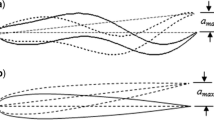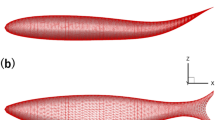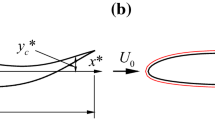Abstract
The effect of the vertical and horizontal distances between dual fish-like foils on the propulsive characteristics of the biomimetic propulsor system is investigated by using an unsteady panel method. The present method is validated by comparing computed results with other numerical and experimental data. The mutual vortex-vortex interaction between the shed vortices from both foils has the effect of changing the pointing direction of mushroom heads. The leading foil’s propulsive characteristics do not change much with the vertical distance between the foils, whereas the following foil’s propulsive characteristics are changed significantly depending on the vertical and horizontal distances between the foils. The overall wake patterns depend mainly on the horizontal distance. The intensity of the mutual interaction between the wake vortices depends on the vertical distance. Thus, the propulsive characteristics of the dual fish-like foils are complicated functions of the vertical and horizontal distances between the foils. The present method has the limitation of potential-low assumption. If the flow separation near the leading edge of the foils is not significant, the present method can be applied to the design of biomimetic propulsors.
Similar content being viewed by others
References
K. V. Rozhdestvensky and V. A. Ryzhov, Aerohydrodynamics of flapping-wing propulsors, Progress in Aerospace Sciences 39 (2003) 585–633.
S. Ho, H. Nassef, N. Pornsinsirirak, Y-C. Tai, and C-M. Ho, Unsteady aerodynamics and flow control for flapping wing flyers, Progress in Aerospace Sciences 39 (2003) 635–681.
M. Sfakiotakis, D. M. Lane, J.B.C. Davies, Review of fish swimming modes for aquatic locomotion, IEEE Journal of Oceanic Engineering 24 (2), (1999) 237–252.
P. R. Bandyopadhyay, Trends in biorobotic autonomous undersea vehicles, IEEE J. Oceanic Eng. 30 (2005) 109–139.
M. S. Triantafyllou, A. H. Techet and F.S. Hover, Review of experimental work in biomimetic foils, IEEE Journal of Oceanic Engineering 29 (3) (2004) 585–594.
R. Knoller, Die gesetze des lufwiderstandes, Flugund Motortechnik(Wien) 3 (21) (1909) 1–7.
A. Betz, Ein beitrag zur erklarung des segelfluges, Zeitschrift fur Flugtechnik und Motorluftschiffahrt 3 (1912) 269–272.
K. D. Jones, C. M. Dohring and M. F. Platzer, Wake structures behind plunging airfoils: a comparison of numerical and experimental results, AIAA 1996-0078.
K. D. Jones and M. F. Platzer, An experimental and numerical investigation of flapping-wing propulsion, AIAA 1999-0995.
J. C. S. Lai and M. F. Platzer, Jet characteristics of a plunging airfoil, AIAA Journal. 37 (12) (1999) 1529–1537.
K. D. Jones, B. M. Castro, O. Mahmoud, and M. F. Platzer, A numerical and experimental investigation of flapping-wing propulsion in ground effect, AIAA 2002-0866.
C. Han, H. J. Lee, J. Cho, Numerical study of biomimetic foil propulsion, Transactions of the KSME Part B. 30 (9) (2006) 866–872.
D. Weihs, Hydromechanics of fish schooling. Nature (London), 241 (1973) 290–291.
D. Weihs, P. W. Webb, Optimization of locomotion. Fish Biomechanics (Edited by Webb P. W. and Weihs D.) Praeger New York (1983) 339–371.
P. R. Bandyopadhyay, J. M. Castano, W. H. Nedderman, and M. J. Donnelly. Experimental simulation of fish-inspired unsteady vortex dynamics on a rigid cylinder, ASME J. Fluids Eng. 122 (2000) 219–238.
M. Akiyama, K. Takato, T. Tsutsui, H. Sugiyama, and N. Ninimiya, Flow around vibrating elastic plates, Proceedings of the 6th Asian Symposium On Visualization, May 28–31 Pusan Korea, (2001) 79–81.
C. Han, J. Cho, Unsteady aerodynamics analysis of flat plates in pitch oscillation, AIAA Journal 20 (6) (2006) 1121–1126.
J. Katz and A. Plotkin, Low-Speed Aerodynamics, 2nd Edition, Cambridge University Press, 40 West 20th Street, New York NY 10011-4211 USA (2001) Chap. 13.
D. T. Mook, S. Roy, G. Choksi and B. Dong, Numerical simulation of the unsteady wake behind an airfoil, Journal of Aircraft 26 (6) (1989) 509–514.
I. H. Tuncer and K. Mustafa, Thrust generation caused by flapping airfoils in a biplane configuration, Journal of Aircraft 40 (3) (2003) 509–515.
J. Yan, R. Wood, S. Avandhanula, R. Sitti, and R. S. Fearing, Towards flapping wing control for a micromechanical flying insect, IEEE International Conference on Robotics and Automation, The IEEE Robotics and Automation Society Seoul Korea (2001) 3901–3908.
Author information
Authors and Affiliations
Corresponding author
Rights and permissions
About this article
Cite this article
Han, C., Lee, H. & Cho, J. Propulsive characteristics of dual fish-like foils. J Mech Sci Technol 22, 171–179 (2008). https://doi.org/10.1007/s12206-007-1021-x
Received:
Revised:
Accepted:
Published:
Issue Date:
DOI: https://doi.org/10.1007/s12206-007-1021-x




